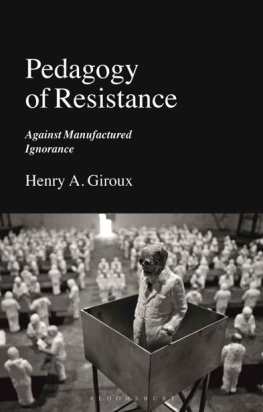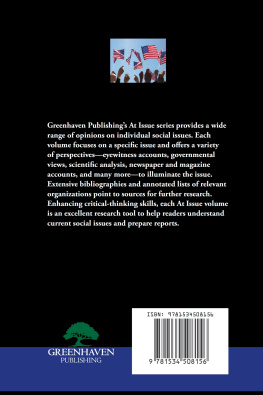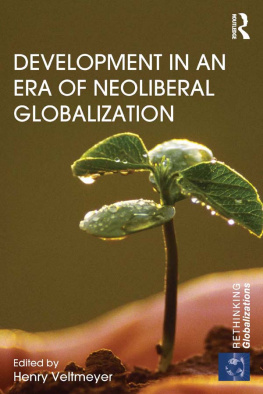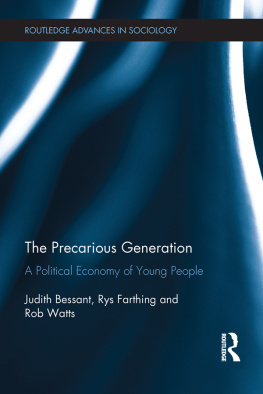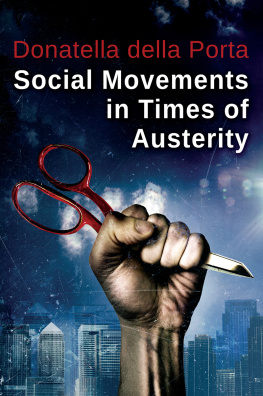First published 2012 by Paradigm Publishers
Published 2016 by Routledge
2 Park Square, Milton Park, Abingdon, Oxon OX14 4RN
711 Third Avenue, New York, NY 10017, USA
Routledge is an imprint of the Taylor & Francis Group, an informa business
Copyright 2012, Taylor & Francis.
All rights reserved. No part of this book may be reprinted or reproduced or utilised in any form or by any electronic, mechanical, or other means, now known or hereafter invented, including photocopying and recording, or in any information storage or retrieval system, without permission in writing from the publishers.
Notice:
Product or corporate names may be trademarks or registered trademarks, and are used only for identification and explanation without intent to infringe.
Library of Congress Cataloging-in-Publication data Giroux, Henry A.
Twilight of the social : resurgent publics in the age of disposability / Henry A. Giroux.
p. cm.
Includes bibliographical references and index.
ISBN 978-1-61205-056-0 (Ebook)
1. United StatesSocial conditions1980 2. United StatesSocial policy1993 3. United StatesPolitics and government2009 I. Title.
HN59.2.G556 2012
303.45097309051dc23
2011031841
Designed and Typeset by Straight Creek Bookmakers.
ISBN 13: 978-1-61205-055-3 (hbk)
ISBN 13: 978-1-61205-056-0 (pbk)

This book would not have been completed on time without the help of many friends who offered invaluable criticisms and support. I would like to especially thank Roger Simon, Donaldo Macedo, and David Theo Goldberg. I am deeply indebted to Grace Pollock, my research assistant, who once again provided detailed editorial suggestions on the entire manuscript, while greatly improving the quality of the overall project. I also want to think Maya Sabados whose skills and help went far beyond any standard measure of excellence. She read each chapter, helped enormously in organizing research notes, and provided much needed support. Susan Searls Giroux took time out of her own busy schedule to read the manuscript, offer a number of important insights, and perform her usual editorial magic. I also want to thank Victoria Harper, my editor at Truthout, for giving me the opportunity to publish some of these pieces. I also want to thank Michael Peters for reprinting a few of these essays in Policy Futures in Education. I also want to extend my deepest appreciation to Dean Birkenkamp, my friend and editor at Paradigm Publishers, for encouraging me to produce this book.
An earlier version of .
American Youth and the Global Fight for Democracy
[O]ne has no choice but to do all in ones power to change that fate [of class and racial oppression], and at no matter what riskeviction, imprisonment, torture, death. For the sake of ones children, in order to minimize the bill that they must pay, one must be careful not to take refuge in any delusion.
James Baldwin1
The people have awakened. If change had happened through elites, there wouldnt have been real change. Now people understand their rights and know how to demand them. They realized their own power.
Ahmed Mahir, leader of the Egyptian Youth April 6th Movement
Within the last year, we have seen an outpouring of student protests from all over the globe. Fifty thousand students took to the streets in London to protest tuition hikes, and thousands of young people in Puerto Rico and Ireland are marching against cuts to student funding and fee increases.2 Students in France and Greece are demonstrating with their bodies, confronting the police, and registering their outrage over the imposition of severe austerity measures. In Spain and Italy, youth are challenging unemployment rates that have soared to 40 and 30 percent, respectively. In Tunisia and Egypt, students have been at the forefront of uprisings that eventually led to the overthrow of authoritarian societies, which for too long forced young people to linger in a liminal space in which there were no jobs, no hope for the future, and far too few freedoms. In Syria and Libya, young people are literally dying because of their brave efforts to reform deeply authoritarian societies. This general sense of frustration among young people is widespread in Europe and the Middle East. For instance, students marching in Rome shouted, We dont want to pay for the crisis, referring to the financial crisis that has turned labor market[s] from bad to worse. Where do I see my future? Certainly not in this country, said protester, Morgana Proietti, expressing a common sentiment.3
Counter-public spheres and modes of resistance that we once did not think young people could mount have erupted in a rush of emotional and political expressions and scattered demonstrations. Mass demonstrations have been organized through the emergent screen cultures of a generation well versed in new technologically assisted forms of social networking and political exchange. Governments complicit with a lethal combination of massive inequality, joblessness, and ongoing cutbacks in social services are now the object of righteous youthful aggression in which buildings are occupied, pitched battles are waged in the streets, banners are dropped from national symbols like the Leaning Tower of Pisa, and once impregnable governmental institutions are subject to intense criticism. Shared sufferings, pent up repressions, ideological longings, and emotional attachments have flared up in a massive collective demand by young people to be part of a future in which justice, democratic values, and politics once again matter. Forging collective spaces of resistance, young people are expressing their long-simmering anger and indignation against harsh injustices, growing inequalities, and insufferable injuries in both totalitarian and allegedly democratic countries. The fear of political transgression and the ensuing repression that kept individual actors in check has given way to a politics in which dissent is amplified, multiplied, and seized upon with a vigor and moral courage that has seldom found such thunderous expression among young people since the late 1970s. Democracy is no longer being defended. It is being reinvented as a kind of shared existence that makes the political possible.4
Moral outrage infused by a complex of affective connections, social despair, and a deeply held sense of shared possibilities has created a spontaneous tsunami of collective protests, strikes, rallies, and demonstrations that have toppled governments, prompted shameless retaliatory outbursts of state terrorism, and further fueled the possibilities for a global sense of resistance among repressed youth everywhere. Young people have used the new media to mobilize mass demonstrations, pitting their bodies against the police, army, and other repressive forces. But they have also used the Internet and various social networks such as Twitter and Facebook to reach across national boundaries. In doing so, they have shared experiences, gathered information, circulated strategies for dealing with the police, and developed nonviolent modes of protest.5 For example, young leaders in Egypt exchanged information with similar youth movements in Libya, Algeria, and Morocco and Iran.6



